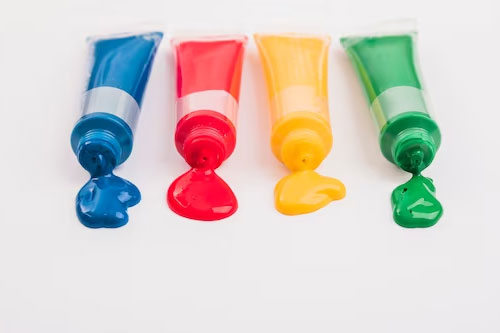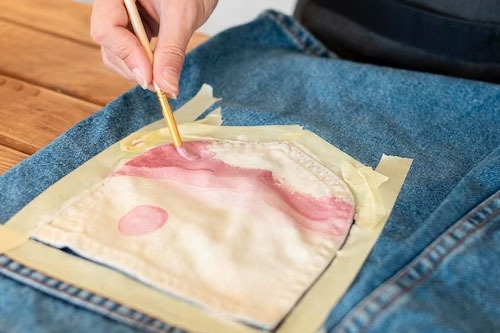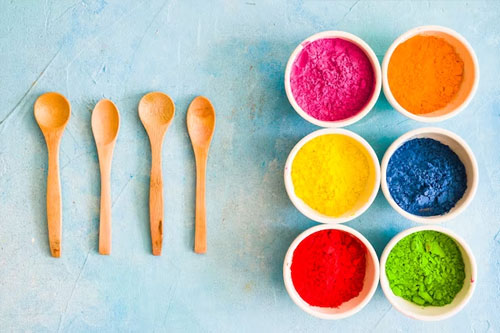Manufacturer, Supplier & Exporter of
a wide range of Dyes, Pigments & Food Colours
Optical Brightener
Optical brightening agents, also known as fluorescent brightening agents, are chemical compounds that are used to brighten the appearance of substrates such as textiles, plastics, paper, and cosmetics. These agents work by absorbing light in the ultraviolet and violet regions and then re-emitting it in the blue region. This blue light then reduces the yellow colour of the substrate, resulting in a brighter and whiter appearance. Unlike bleaching, optical brightening agents do not leave a yellowish tinge, making them a popular choice for achieving a pleasing whiter-than-white appearance.
Optical brightening agents have several unique properties that make them highly desirable in various industries. These properties include their ability to enhance the brightness of materials, their low toxicity levels, and their compatibility with various substrates.
Optical brighteners in textiles are commonly used in the production of white fabrics and to enhance the whiteness of coloured fabrics. They are also used in laundry detergents to give a brightening effect to clothes. Optical brighteners for plastic are added to various plastic products, including packaging, to improve their appearance. They are also used in the production of white and coloured films, fibers, and moulded plastic products. Optical brighteners in paper are used to increase the brightness and whiteness of paper products, including printing papers, tissues, and paperboards. In the cosmetics industry, optical brightening agents are used to enhance the whiteness of various products, including skin creams, lotions, and powders.
Megha International is a leading among one of the leading optical brightener manufacturers, offering a wide range of high-quality products to various industries. With over two decades of experience in the industry, Megha International has established itself as a trusted supplier of optical brightening agents, delivering products that meet the highest standards of quality and performance. The company’s product range includes optical brightening agents for textiles, plastics, paper, and cosmetics, and it has a strong global presence, exporting its products to several countries worldwide. Megha International’s commitment to innovation, quality, and customer satisfaction has made it a preferred supplier of optical brightening agents in the industry.
Inorganic Pigments have a number of properties that make them highly desirable for use in various industries. They are highly durable, have excellent hiding power, and are highly resistant to fading and weathering. They are also highly stable and can withstand exposure to a wide range of chemicals and solvents.
Inorganic Pigments have a wide range of applications across various industries, including paints, coatings, plastics, ceramics, and textiles. They are used to impart colour to a wide range of products, from cars and buildings to clothing and furniture. They are also used in printing inks and toners, as well as in the manufacturing of specialty papers.
Megha International is a leading Inorganic pigments manufacturer, based in India. The company produces a wide range of Inorganic pigments for various applications, including paints, inks, plastics, and textiles. Megha International’s industrial Inorganic pigments are known for their high quality and excellent colour properties. The company has a strong focus on research and development, constantly striving to improve the performance of its pigments and develop new and innovative products. With a commitment to sustainability and ethical business practices, Megha International is a trusted partner for companies around the world looking for high-quality Inorganic pigments. For more information, click on Inorganic pigments pdf
Are you looking for Optical Brightener? Transform your materials into vibrant masterpieces!
Buy High quality Optical Brightener at Best Price - Megha International

Types of Optical Brighteners
Optical brightening agents (OBAs) are classified into different types based on their chemical structure and degree of sulfonation.
Disulfonated optical brightening agents are a type of OBA that contains two sulfonic acid groups. They are commonly used in detergents, paper products, and textiles, such as in the brightening of cotton and wool fibers.
Tetrasulfonated optical brightening agents contain four sulfonic acid groups and are more efficient than disulfonated OBAs. They are commonly used in detergents, paper products, and textiles to achieve high levels of whiteness and brightness.
Hexanesulfonate OBAs contain six sulfonic acid groups and are the most efficient type of OBA available. They are commonly used in high-end applications, such as in the brightening of optical fibers, plastics, and coatings.
Overall, the degree of sulfonation plays a crucial role in the effectiveness of OBAs. Manufacturers carefully select the type of OBA based on the substrate and application requirements to achieve the desired results.
Optical Brightening Agent Manufacturing Process
The manufacturing process of optical brightening agents involves several steps, including synthesis, purification, and formulation.
Synthesis: The first step in the manufacturing process is the synthesis of the optical brightening agent. This is done by reacting two or more chemical compounds under controlled conditions to produce the desired product. The synthesis process may involve several steps and may be conducted in batch or continuous reactors.
Purification: Once the optical brightening agent has been synthesized, it is purified to remove any impurities or by-products that may have formed during the reaction. Purification may involve several techniques, such as crystallization, distillation, or chromatography.
Formulation: After purification, the optical brightening agent is formulated into a final product that can be used in various applications. Formulation may involve adding other chemicals or ingredients to enhance the performance of the product or to adjust its properties.
Quality Control: Throughout the manufacturing process, quality control measures are implemented to ensure that the final product meets the desired specifications. These measures may include analytical testing, process monitoring, and product performance testing.
Packaging: Finally, the optical brightening agent is packaged into containers that are suitable for storage and transportation. Packaging may involve filling the product into bags, drums, or bulk containers, depending on the quantity and application of the product.
Overall, the manufacturing process of optical brightening agents is complex and involves several steps to ensure the production of a high-quality product that meets the specific requirements of various industries.
List of Optical Brighteners
To know more in details about the classification of Optical Brightener
OPTICAL BRIGHTENERS Properties / Characteristics - OPTICAL BRIGHTENERS Manufacturer in India
Optical brighteners (OBAs) have several properties and characteristics that make them useful in a wide range of applications. Some of the key properties of OBAs include:
- Fluorescent: OBAs absorb UV and violet light and re-emit blue light, creating a whitening effect on the substrate.
- Water-soluble: OBAs are generally soluble in water, making them easy to apply to a range of substrates.
- pH-sensitive: The effectiveness of OBAs can be affected by pH levels. They work best in slightly acidic to neutral conditions.
- Heat-sensitive: OBAs can be sensitive to high temperatures and may break down or lose effectiveness if exposed to excessive heat.
- Chemical stability: OBAs are generally stable under normal conditions and do not react with other chemicals in the substrate.
- High efficiency: OBAs are highly efficient at brightening substrates, with only small amounts required to achieve desired levels of whiteness and brightness.
- Non-toxic: OBAs are generally considered safe for use in a wide range of applications and are not toxic to humans or animals.
Overall, the properties of OBAs make them a popular choice for a range of industries, including textiles, plastics, paper, and cosmetics. Manufacturers carefully select the type of OBA based on the substrate and application requirements to achieve the desired results.

Advantages of OPTICAL BRIGHTENERS
Optical brighteners (OBAs) offer several advantages in various applications, including:
- Increased brightness: OBAs can brighten and whiten substrates, making them more visually appealing and attractive.
- Improved color contrast: OBAs can reduce the yellow tint in substrates, which can improve color contrast and make colors appear more vivid.
- Minimal color loss: OBAs do not cause significant color loss or fading, unlike bleaching agents that can lead to discoloration and damage.
- Increased durability: OBAs can improve the durability and lifespan of substrates by protecting them from UV damage and other environmental factors.
- Cost-effective: OBAs are generally cost-effective compared to other methods of achieving brightness, such as bleaching or dyeing.
- Safe for use: OBAs are non-toxic and safe for use in a wide range of applications, making them a popular choice for industries such as textiles, plastics, and cosmetics.
Overall, OBAs offer several advantages in terms of cost, safety, and performance, making them a versatile and useful option for a range of applications.
Optical Brightener Uses
Optical brighteners (OBAs) are widely used in various industries to improve the brightness, whiteness, and colour contrast of substrates. Here are some of the common applications of OBAs by industry:

Textile industry
OBAs are used in the textile industry to brighten and whiten fabrics such as cotton, wool, and silk. They are commonly used in laundry detergents, fabric softeners, and fabric conditioners.

Paper industry
OBAs are used in the paper industry to improve the brightness and whiteness of paper products such as newspapers, magazines, and printing paper. They are commonly used in coatings, inks, and other paper additives.

Plastics industry
Optical brighteners for plastic are used to improve the whiteness and brightness of plastic products such as films, fibers, and moulded items. They are commonly used in polyethylene, polypropylene, and other plastic materials.

Cosmetic industry
OBAs are used in the cosmetic industry to improve the brightness and whiteness of skin care and personal care products such as lotions, creams, and shampoos. They are commonly used in sunscreen products to enhance their UV-absorbing properties.

Food industry
OBAs are used in the food industry to improve the brightness and whiteness of food packaging materials such as plastic films and paperboard. They are also used in food products such as candies and chewing gum to enhance their visual appeal.
About Megha International
Looking for an OPTICAL BRIGHTENERS Exporter for brazil?
Megha International (ISO 9001: 2008) Established in the year 1995, at Mumbai, India is the best optical brightener manufacturers in India that offers an extensive range of dyes in the national as well as international optical brighteners market. Our research and development team carries out constant studies to develop products that reliably set us apart from our competitors and serve our clienteles best. With a remarkable focus on innovation and leveraging new-age expertise, we endeavour to sustain and develop a leading organization on a global scale. The company is a top OPTICAL BRIGHTENERS manufacturer in India, and is striving to deliver the finest quality of products to the consumers, while being environmentally sensitive.
Market Area of Megha International
As a prominent OPTICAL BRIGHTENERS supplier, Megha International is proud to export OPTICAL BRIGHTENERS in a wide range of countries across the globe. Our reach extends to many countries in Asia, including China, Vietnam, Singapore, Thailand, Malaysia, Korea, Philippines, Japan, and Indonesia.
We also serve clients in the Middle East, such as UAE, Saudi Arabia, Kuwait, Qatar, Iraq, and Iran.
In North Africa, we have clients in Algeria, Morocco, and Tunisia, while in Europe, we offer our services to Russia, the UK, France, Italy, Germany, the Netherlands, Romania, and Poland.
In South America, we serve clients in Brazil, Argentina, Colombia, Peru, and Guatemala, as well as in Central America, including Mexico, Costa Rica, and Honduras.
Finally, we also provide our services to clients in the United States and Chile. No matter where our clients are located, we are committed to delivering high-quality dyes and exceptional customer service.
Frequently Asked Question about Vat Dyes
Optical brighteners are generally considered safe for use in various applications and are non-toxic. However, some individuals may experience skin irritation or allergic reactions when exposed to OBAs, particularly in cosmetic products. It is always recommended to follow product instructions and consult a doctor if any adverse reactions occur.
Optical brighteners are a common ingredient in laundry detergents and fabric softeners. They work by absorbing UV light and re-emitting blue light, which helps to enhance the brightness and whiteness of fabrics. Some laundry detergents are specifically formulated without optical brighteners for individuals who may be sensitive to them.
To remove optical brighteners from clothes, it is recommended to wash them in hot water with a mild detergent that does not contain any optical brighteners. Avoid using fabric softeners or dryer sheets, as they may contain OBAs. You can also hang your clothes to dry in the sun, as sunlight can help to naturally whiten and brighten fabrics.
Optical brighteners work by absorbing UV light and re-emitting blue light, which helps to enhance the brightness and whiteness of substrates. They are designed to absorb light in the ultraviolet and violet region and then re-emit light in the blue region, which reduces the yellow color of the substrate and creates a brighter appearance.
Optical brighteners are not readily biodegradable, which means they do not break down easily in the environment. However, they are generally considered safe and non-toxic, and their use is regulated by various agencies to ensure environmental safety.
Optical brighteners are typically used on white or light-colored fabrics to enhance their brightness and whiteness. Using OBAs on colored fabrics may affect the color and cause fading, so it is not recommended.
Optical brighteners are commonly found in laundry detergents, fabric softeners, paper products, plastics, cosmetics, and food packaging materials. They are used to improve the brightness, whiteness, and color contrast of substrates.
Optical brighteners are not considered toxic to the environment, but they are not readily biodegradable and can accumulate in waterways and ecosystems. The use of OBAs is regulated by various agencies to ensure environmental safety.
Some individuals may experience skin irritation or allergic reactions when exposed to optical brighteners, particularly in cosmetic products. It is always recommended to follow product instructions and consult a doctor if any adverse reactions occur.
The longevity of optical brighteners depends on various factors, such as the substrate, the concentration of OBAs, and the environmental conditions. In general, OBAs can last for several washes or uses, but their effectiveness may diminish over time.


